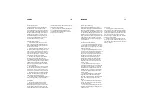
Before first use
Make sure you oil the butcher’s block be
-
fore using it for the first time. This will help
to increase its natural resistance to moisture
and make it easier to wipe off grease
and marks. Use only oil that is suitable for
contact with food, such as mineral oil or
vegetable oil. Spread plenty of oil all over
the butcher’s block. Allow it to soak into
the wood and then wipe off any surplus.
Repeat the treatment after 24 hours.
Looking after your butcher’s block
— To make sure the butcher’s block gets
perfectly clean and to avoid development
of bacteria, the rubber strip should be
removed before cleaning. The rubber strip
should be washed by hand.
— Clean the block by wiping it with a wet
cloth or scrubbing with a brush. Moisten
both sides of the block. The wood will dry
more evenly and the risk of warping is
reduced. Do not allow the product to re
-
main in contact with water for a prolonged
period. Do not soak it and do not leave it
under running water as this can cause the
wood to split.
— Dry the block carefully, but do not
subject the wood to a high temperature to
speed up the drying process. Never leave
the block to dry on a sink top above a dish
-
washer or close to a heater since drying at
a high temperature can cause the wood to
split.
— Always stand the block on one of the
long sides when it is drying so that the air
can dry as many sides as possible. If it is
dried lying flat, the wood may warp.
— Oil the wood at regular intervals. How
often depends on how frequently the prod
-
uct is used and for what purpose.
— To recondition the butcher’s block, rub
down the surface carefully with sandpaper
and re-oil.
A few words of advice
— It is a good idea to use different chop
-
ping boards for different types of food.
Uncooked chicken, for example, may con
-
tain bacteria that should not be allowed to
come into contact with foods that are eaten
raw. Utensils and chopping boards that
have come into contact with raw chicken
should therefore always be washed very
carefully.
— It is also advisable to use separate
chopping boards for foods such as onion,
fish etc. These have strong smells that can
easily be transferred to other ingredients.
Vor der ersten Benutzung
Den Fleischhauerblock vor der ersten
Benutzung einölen. Dadurch wird er be
-
ständiger gegen Feuchtigkeit und Fett- und
Schmutzflecken lassen sich leichter abwi
-
schen. Nur Öl verwenden, das für den Ge
-
brauch mit Lebensmitteln geeignet ist wie
pflanzliche Öle oder Paraffinöl. Reichlich Öl
auf dem Block verteilen. Das Öl einziehen
lassen, evtl. Überschuss abwischen und die
Behandlung nach 24 Stunden wiederholen.
Reinigung und Pflege
— Zur gründlichen Säuberung des Hack
-
blocks und zur Vermeidung von Bakterien
sollte die Gummileiste beim Reinigen ent
-
fernt werden. Die Gummileiste von Hand
spülen.
— Zum Reinigen das Brett feucht abwi
-
schen oder mit einer Bürste abschrubben.
Zum Spülen den Block auf beiden Seiten
anfeuchten. So trocknet das Material
gleichmäßig und das Risiko, dass sich das
Holz wirft, wird gemindert. Den Hackblock
nicht längere Zeit in Kontakt mit Wasser
bringen, nicht im Spülwasser liegen oder
unter fließendem Wasser stehen lassen, da
sonst Risse im Holz entstehen könnten.
— Den Block sorgfältig abtrocknen, den
Trockenvorgang jedoch nicht durch hohe
Temperaturen forcieren. Z.B. empfiehlt es
sich nicht, das Produkt auf der Arbeitsplatte
über der Spülmaschine oder in der Nähe
der Heizung zu trocknen. Trocknen bei
hohen Temperaturen kann das Holz reißen
lassen.
— Den Hackblock immer stehend mit einer
Längsseite nach unten trocknen lassen,
damit die Luft an möglichst viele Seiten
kommt. Wenn das Produkt beim Trocknen
aufliegt, kann das Holz sich werfen.
— Das Produkt regelmäßig einölen. Wie
oft, hängt davon ab, wie häufig und für
welche Zwecke der Block benutzt wird.
— Für eine grundlegende Auffrischung
kann die Oberfläche mit Schleifpapier ab
-
geschliffen und erneut eingeölt werden.
Wissenswertes
— Es empfiehlt sich, für verschiedene
Lebensmittel verschiedene Schneidebretter
zu verwenden. Rohes Geflügelfleisch z.B.
kann Bakterien enthalten und sollte nicht
mit Lebensmitteln in Kontakt kommen, die
roh gegessen werden. Schneidebretter
und Utensilien, die mit rohem Geflügel
-
fleisch in Berührung gekommen sind, sollten
immer besonders sorgfältig abgewaschen
werden.
— Außerdem ist es ratsam für Lebensmittel
wie Zwiebeln, Fisch etc. separate Schnei
-
debretter zu benutzen. Der starke Geruch
könnte sich sonst auf andere Zutaten
übertragen.
ENGLISH
DEUTSCH
4
5
Содержание EXKLUSIVT
Страница 1: ...EXKLUSIVT Inter IKEA Systems B V 2009 AA 458191 1...
Страница 2: ......





























